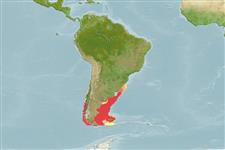Common names from other countries
Classification / Names / Names
Namen | Synonyme | Catalog of Fishes (gen., sp.) | ITIS | CoL | WoRMS
Environment: milieu / climate zone / depth range / distribution range
Ökologie
; tiefenbereich 2 - 250 m (Ref. 87801). Temperate, preferred 12°C (Ref. 107945); 30°S - 55°S, 76°W - 50°W
Southeast Pacific and Southwest Atlantic: from Valparaiso to Magallanes, Rio Grande do Sul, Brazil then south to Falkland Islands.
Length at first maturity / Size / Gewicht / Alter
Maturity: Lm ? range ? - ? cm Max length : 2.8 cm SHH Männchen/unbestimmt; (Ref. 81902)
Maximum length is based on data from Chile (Ref. 81902). Maximum depth from Ref. 111854. It is an infaunal species found on sandy, muddy, gravel and shell covered substrates at depths of 2 to 80 meters. Gonochoric species with free-living larvae (Ref. 87801). It is found in forests of Macrocystis pyrifera (Ref. 92889).
Life cycle and mating behavior
Geschlechtsreife | Fortpflanzung | Ablaichen | Eier | Fecundity | Larven
Members of the class Bivalvia are mostly gonochoric, some are protandric hermaphrodites. Life cycle: Embryos develop into free-swimming trocophore larvae, succeeded by the bivalve veliger, resembling a miniature clam.
SAUP Database. 2006. (Ref. 356)
IUCN Rote Liste Status (Ref. 130435)
CITES Status (Ref. 108899)
Not Evaluated
Not Evaluated
Nutzung durch Menschen
Fischereien: kommerziell
FAO - Fischereien: landings | FishSource | Sea Around Us
Tools
Internet Quellen
Estimates based on models
Widerstandsfähigkeit
mittel, Verdopplung der Population dauert 1,4 - 4,4 Jahre. (K=0.29).
